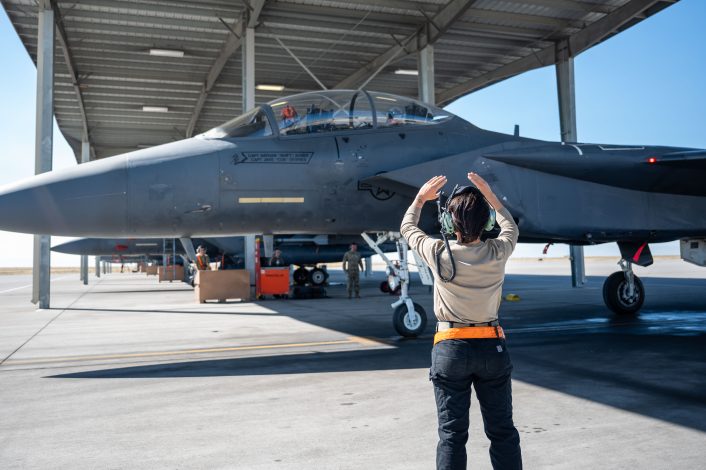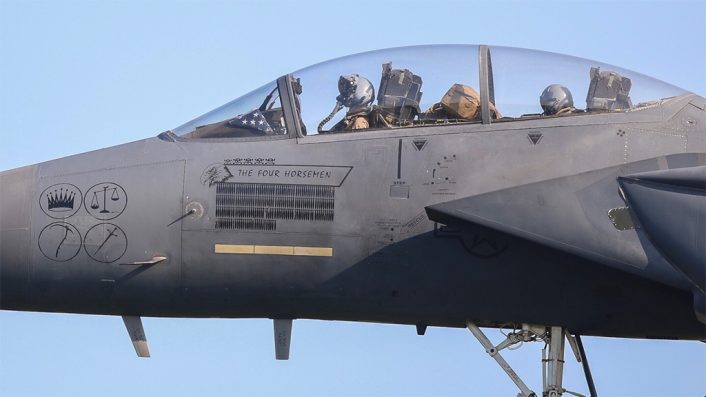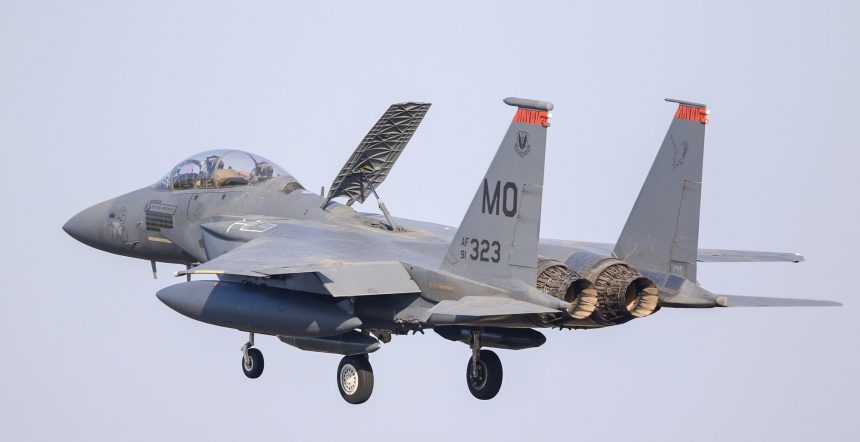The F-15E Strike Eagle remained grounded for four years due to a landing gear issue.
After spending more than four years grounded due to a landing gear malfunction, F-15E Strike Eagle 91-0323 has finally returned to operational status. The recovery of this aircraft, that was completed with the FCF (Final Check Flight) on Oct. 2, 2024, marks a significant victory for the dedicated maintainers of the 391st Fighter Generation Squadron at Mountain Home Air Force Base, Idaho. Their journey to restore the jet was a challenging endeavor filled with technical hurdles, yet through perseverance, teamwork, and leadership, they were able to bring the aircraft back to life.
At the forefront of this ambitious recovery effort was Master Sgt. Donald Root, the lead Production Superintendent at the 391st Fighter Generation Squadron. Root witnessed the jet’s transformation from a damaged, non-flyable aircraft to one that is once again mission-ready. The journey began around 1,500 days ago when the aircraft’s landing gear malfunctioned during an incident on the runway.
Recalling that day, Root shared the critical moment when he and his crash recovery team approached the grounded aircraft, in a public release. “We coordinated with the fire squadron to secure the area and ensure safety while we prepared to lift the aircraft off the runway,” Root explained. This moment marked the beginning of what would become a long and arduous process to bring F-15E 323 back into the skies.

The rebuilding process for the Strike Eagle was a monumental task, requiring the collective effort of multiple teams across the base. From the time the aircraft was cleared for repairs, nearly every maintenance shop had a hand in its revival. The collaboration between various Depot Field Teams, local maintenance shops, and specialists from across Mountain Home AFB proved to be essential in overcoming the challenges ahead.
“Every shop on base has touched this aircraft. It’s truly a collective effort,” said Root, reflecting on the scale of collaboration required to restore the aircraft. This sentiment was echoed by Staff Sgt. Alex Torres, the lead floor supervisor and crew chief for the project. “My team and I coordinated closely with other shops, like fuels and sheet metal, to ensure a smooth workflow. It was essential to time our tasks right so that nothing obstructed progress,” Torres said.
The task of restoring F-15E 323 came with its share of complications. One of the most difficult aspects of the rebuild involved reinstalling the landing gear, a delicate operation that required addressing damage to critical components of the aircraft. Additionally, the team had to fabricate custom parts from titanium, a material they had never worked with before, further complicating the process.
Despite these challenges, Torres emphasized the importance of teamwork throughout the rebuild. “The biggest lesson I learned was the value of teamwork. We gave it our all every step of the way and fostered new friendships along the way.” The difficulties they encountered, including reworking a damaged wire harness in the right wing that required a complete rewiring, demonstrated the team’s resourcefulness and ability to overcome obstacles through collaboration.
Another significant factor in the rebuild was the need for proper funding and scheduling. “Funding was a major factor that affected our timeline. We had to ensure everything was in place before moving forward with the rebuild,” said Root. The complex nature of the repairs, combined with funding challenges, meant the team had to be flexible and patient in tackling each new problem as it arose.
For many on the team, the experience was not only an opportunity to work on a critical Air Force asset but also a chance for personal growth. Torres, who had recently been promoted to Staff Sgt. when the rebuild began, had to step into a leadership role for the project. “As a brand-new Staff Sgt., I had to learn quickly and trust my intuition to get the job done. I couldn’t have done it without the support of my team,” Torres said.
Despite the many challenges and setbacks, the hard work and dedication of the maintenance team paid off. F-15E 323 recently passed a series of rigorous qualifying tests and successfully completed a test flight, marking its return to operational status. Watching the aircraft take to the skies was a moment of triumph for the team. “It was truly an amazing feeling to see 323 break ground,” Root said. “This milestone is a true testament to all the hard work and dedication from the men and women of the 366 Maintenance Group.”
The return of F-15E Strike Eagle 323 is more than just the restoration of a machine; it is a story of resilience, teamwork, and the unwavering commitment of the Gunfighter maintainers. As Master Sgt. Root reflected on the journey, he emphasized the importance of the aircraft to the Air Force and the role it plays in ensuring mission readiness. “Every aircraft tells a story, and the story of 323 is one of teamwork and determination. We’re excited to see it back in the skies, ready for its mission.”
Interestingly, the F-15E was one of the 18 F-15E Strike Eagle jets belonging to the 391st Expeditionary Fighter Squadron, deployed to the Middle East in support of OIR (Operation Inherent Resolve) until mid April 2019. As we reported back then, photographs taken at RAF Lakenheath, UK, as the aircraft returned to their homebase, showed that all the jets sported unique mission markings, nicknames and nose arts. In particular, 91-0323 was nicknamed The Four Horsemen.










